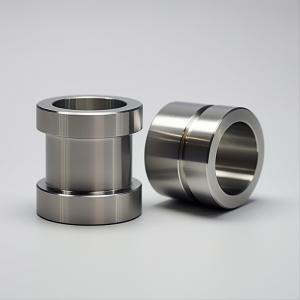
Add to Cart
The CNC machining process, standing for computer numerical control machining, is a subtractive
manufacturing approach that utilizes a synergy of computerized controls and machine tools to
eliminate layers from a solid block of material. Programming dictates the desired cuts in the metal,
aligning them with specific tools and machinery, and the automated process executes the machining
task accordingly.
Product Details
CNC turning is a versatile machining process that can effectively work with various materials.
These materials include metals like aluminum, steel, brass, and titanium, as well as plastics
such as acrylic, nylon, and polycarbonate.
| Common Materials | |
| Name | Description |
| Aluminum | High machinability and ductility, good strength-to-weight ratio. |
| Stainless steel | High tensile strength, corrosion and temperature resistant. |
| Mild steel | High machinability and weldability, high stiffness. |
| Brass | Low friction, excellent electrical conductivity, golden appearance. |
| Copper | Excellent thermal and electrical conductivity. |
| Titanium | Excellent strength to weight ratio, used in aerospace, automotive and medical industries. |
| POM | High stiffness, high accuracy, low friction, easy to machine. |
| ABS | Common thermoplastic, impact resistant, easy to machine. |
| Nylon | Excellent mechanical properties, thermal, chemical and abrasion resistant. |



| CNC Turning Tolerances | ||
| Limits for nominal size | Plastics | Metals |
| 0.5mm* to 3mm | ±0.1mm | ±0.05mm |
| Over 3mm to 6mm | ±0.1mm | ±0.05mm |
| Over 6mm to 30mm | ±0.2mm | ±0.10mm |
| Over 30mm to 120mm | ±0.3mm | ±0.15mm |
| Over 120mm to 400mm | ±0.5mm | ±0.20mm |
| Over 400mm to 1000mm | ±0.8mm | ±0.30mm |
| Over 1000mm to 2000mm | ±1.2mm | ±0.50mm |
| Over 2000mm to 4000mm | ±2.0mm | |
| *Please clearly indicate tolerances for nominal sizes below 0.5mm on your technical drawing. | ||
Typical Applications of CNC Turning
CNC turning machines offer versatility in producing a wide array of components, ranging in
complexity. Here are examples of parts that can be crafted using CNC turning:
1. Shafts and Axles: CNC turning excels in fabricating elongated, cylindrical parts found in
diverse sectors, including automotive and aerospace.
2. Bushings and Bearings: Precision-manufactured bushings and bearings are indispensable
in mechanical systems, reducing friction and facilitating smooth rotational motion.
3. Connectors and Fittings: CNC turning allows for the production of connectors, fittings,
and couplings utilized in plumbing, hydraulic systems, and electrical applications.
4. Fasteners: Screws, bolts, and nuts, crafted with CNC turning, serve as essential components
for assembling various parts in multiple industries, ensuring secure connections.
5. Valves and Valve Components: CNC turning permits the creation of valve bodies, stems,
seats, and intricate components used in fluid control systems.
6. Tooling Components: This includes inserts, toolholders, and bodies utilized in machining
operations, enhancing operational efficiency and precision.
7. Automotive Parts: CNC turning is employed in the production of engine components, pulleys,
brackets, and specialized parts for the automotive industry.

Company Profile


FAQ's
1. What are the minimum and maximum dimensions you can machine?
Our comprehensive CNC machining services cover milling (3-axis, 3+2-axis, and 5-axis) and
turning processes.
In 3/3+2-axis CNC milling, we can achieve part dimensions up to 2000 x 1500 x 200 mm
(78.7 x 59.0 x 7.8 in.). For 5-axis milling, the maximum part size is 650 x 650 x 300 mm
(25.5 x 25.5 x 11.8 in.). CNC turning accommodates a maximum diameter of 431 mm (17 in.)
and a length of 990 mm (39 in.).
Smaller parts are recommended to have dimensions around 10 x 10 x 10 mm
(0.39 x 0.39 x 0.39 in.), with a minimum feature size of 0.5 mm. It's important to be aware that
our platform imposes a maximum part size of 1000 mm (39 in.), and for larger requirements,
we encourage you to contact our sales team for tailored support.
2. How much do CNC machining materials cost?
The multitude of materials available for CNC machining introduces a range of costs, influenced by
the unique properties and characteristics of each material. In the realm of metal parts,
Aluminum 6061 is a standout for its economical pricing. If cost efficiency is a priority, ABS takes
the lead as the most budget-friendly option.
Importantly, the ease of machining is a key factor impacting costs. Stainless steel, known for its
hardness in comparison to aluminum, presents higher machining complexities, contributing to an
overall increase in costs.
3. Can passivate my parts?
Passivation is a treatment designed to change the surface chemistry of select metals.
We offer passivation services to provide corrosion protection, improve durability, enhance aesthetics,
and more.
4. What are you shipping terms?
Our standard shipping terms, applicable to both rapid prototyping and regular production orders,
are Ex Works (EXW). Under these terms, the customer assumes responsibility for shipping, customs
clearance, and all associated fees once the goods have left our premises.
For express shipments, we follow the Delivered Duty Unpaid (DDU) model, placing the onus on the
client to pay import duty upon the goods reaching their destination.